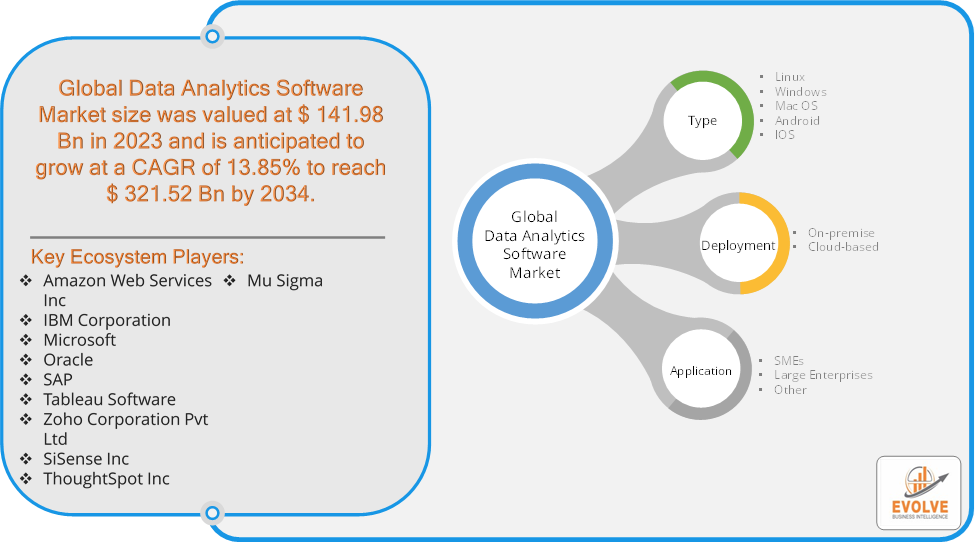Blog
Data Analytics Software Market Surges: 13.85% CAGR

Evolve Business Intelligence has published a research report on the Global Data Analytics Software Market, 2024–2034. The global Data Analytics Software Market is projected to exhibit a CAGR of around 13.85% during the forecast period of 2024 to 2034.
Evolve Business Intelligence has recognized the following companies as the key players in the global Data Analytics Software Market: Amazon Web Services Inc, IBM Corporation, Microsoft, Oracle, SAP, Tableau Software, Zoho Corporation Pvt Ltd, SiSense Inc, ThoughtSpot Inc and Mu Sigma.
The Global Data Analytics Software Market is projected to be valued at USD 321.52 Billion by 2034, recording a CAGR of around 13.85% during the forecast period. The Global Data Analytics Software Market refers to the global industry focused on the development, sale, and implementation of software solutions designed to analyze, process, and interpret large volumes of data. These software tools are used by organizations across various sectors to extract actionable insights from raw data, aiding in decision-making, operational efficiency, and business strategy.
The market is driven by factors such as the increasing adoption of big data technologies, growing demand for cloud-based solutions, and the rising need for businesses to gain a competitive edge through data-driven strategies. The global data analytics software market is a dynamic and rapidly evolving field that plays a crucial role in helping organizations unlock the potential of their data assets.
Download the full report now to discover market trends, opportunities, and strategies for success.
Segmental Analysis
The global Data Analytics Software Market has been segmented based on Type, Deployment and Application.
Based on Type, the Data Analytics Software Market is segmented into Linux, Windows, Mac OS, Android and IOS. The Windows segment is anticipated to dominate the market.
Based on Deployment, the global Data Analytics Software Market has been divided into On-premise and Cloud-based. The On-premise segment is anticipated to dominate the market.
Based on Application, the global Data Analytics Software Market has been divided into SMEs, Large Enterprises and Other. The Large Enterprises segment is anticipated to dominate the market.
Regional Analysis
The global Data Analytics Software Market is divided into five regions: North America, Europe, Asia-Pacific, South America, and the Middle East, & Africa. North America remains the largest and most mature market for data analytics software, with a significant presence of established players and a strong focus on innovation and the region benefits from a well-developed IT infrastructure, a large number of data-intensive industries, and a high level of awareness about the value of data analytics. Europe is witnessing rapid growth in the data analytics market, driven by factors such as increasing digitalization, regulatory compliance requirements, and a focus on data-driven innovation and the region is characterized by a diverse landscape of players, including large enterprises, small and medium-sized businesses, and startups. The Asia-Pacific region is the fastest-growing market for data analytics software, fueled by rapid economic growth, increasing digitalization, and a growing emphasis on data-driven decision-making and the region offers significant opportunities for growth, particularly in countries such as China, India, and Japan, which are experiencing rapid urbanization and industrialization. Latin America is an emerging market for data analytics software, with significant potential for growth driven by increasing digitalization, government initiatives, and the need for improved decision-making and the region faces challenges such as infrastructure limitations, economic volatility, and a lack of skilled talent in data analytics. The Middle East and Africa region is experiencing growing demand for data analytics software, driven by factors such as economic development, government initiatives, and the need for improved efficiency and competitiveness.


